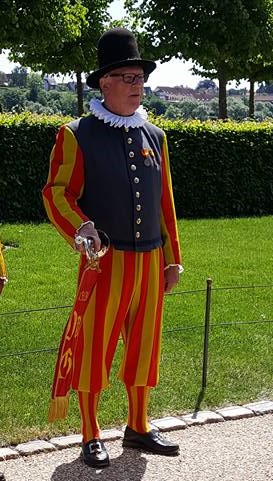Our uniform is a faithful copy of the uniform worn by the royal halberdier guard when it was created in 1571, albeit with a few compromises of a technical nature. It consists of a black hat with a high brim, a white pipe collar, and a gray jacket
brass buttons and red and yellow striped sleeves. Likewise striped pants/trousers, and ditto socks and black shoes, with silver buckles.
Today, the uniform probably seems a bit odd and maybe even comical, but there is an explanation for that:
The stripes have their color composition, red and yellow, because precisely these colors were the colors of the Oldeburg house (royal house). The stripes must partly be seen as a fashion phenomenon of the time, when many colors equaled prosperity. It also had a practical aspect: If part of the uniform was damaged, you could just replace the strip(s) of fabric on which the damage had occurred.
Short pants/trousers were a must, as the surface you walked on was usually very dirty. This way you could keep the trousers from getting dirty, and thus wash them less (which had to be done by hand, and certainly without soap).
The socks were long enough to reach the pants/trousers, and had the advantage of being knitted instead of woven. This reduced costs tremendously and made repairs easier.
The pipe collar had arisen in connection with the potato arriving in the country. It (of course) doesn't immediately make sense, but the explanation follows: The first thing people used the potato for in Europe was powder. What we know today as potato flour was used in the 16th century as a hair care product. Shampoo wasn't invented, but greasy hair was. That is why they put potato flour in their hair to absorb it. The disadvantage then consisted in the fact that it could stain one's clothes.
The result was the pipe collar, which could then collect both flour and dander, but as with so much else, it became fashionable: To show status and prosperity, the pipe collars could achieve enormous dimensions, and the practical element then became secondary.
The reason why today we associate the appearance of the uniform with clowns also has a completely logical explanation: When the next big craze hit the world (Baroque), people confirmed their ideas and ideals by disparaging the previous one. Thus, jesters and other entertainers were dressed in parodies of old clothing. This lasted for a long time, and therefore we have to this day, an impression of the fashion of the time, as something fool and clown-like. It is the same mechanism in the human mind that makes us laugh at the neon colors and plastic jewelry of the 1980s today.



